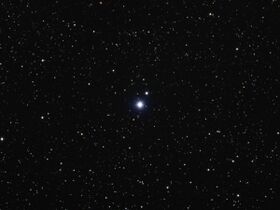Astronomy:Nu Geminorum
| Observation data Equinox J2000.0]] (ICRS) | |
|---|---|
| Constellation | Gemini |
| Right ascension | 06h 28m 57.78613s[1] |
| Declination | +20° 12′ 43.6856″[1] |
| Apparent magnitude (V) | 4.16[2] |
| Characteristics | |
| Spectral type | B6 III + B8 III[3] |
| U−B color index | −0.47[2] |
| B−V color index | −0.13[2] |
| Astrometry | |
| Radial velocity (Rv) | +39.4[4] km/s |
| Proper motion (μ) | RA: −6.82[1] mas/yr Dec.: −13.10[1] mas/yr |
| Parallax (π) | 5.99 ± 0.28[1] mas |
| Distance | 540 ± 30 ly (167 ± 8 pc) |
| Absolute magnitude (MV) | −2.2 + −1.2[3] |
| Orbit[5] | |
| Primary | ν Gem Aa |
| Companion | ν Gem Ab |
| Period (P) | 53.7722 ± 0.0008 d |
| Semi-major axis (a) | 2.82 ± 0.02 mas |
| Eccentricity (e) | 0.056 ± 0.003 |
| Inclination (i) | 0.98 ± 0.03° |
| Longitude of the node (Ω) | 78.9 ± 0.2° |
| Periastron epoch (T) | MJD 51011.8 ± 0.1 |
| Argument of periastron (ω) (secondary) | 6.7 ± 2.0° |
| Semi-amplitude (K1) (primary) | 51.6 ± 0.6 km/s |
| Semi-amplitude (K2) (secondary) | 52.5 ± 1.1 km/s |
| Orbit[5] | |
| Primary | ν Gem A |
| Companion | ν Gem B |
| Period (P) | 6977.3 ± 6.1 |
| Semi-major axis (a) | 82.8 ± 1.3 mas |
| Eccentricity (e) | 0.241 ± 0.002 |
| Inclination (i) | 75.9 ± 0.2° |
| Longitude of the node (Ω) | 121.0 ± 0.1° |
| Periastron epoch (T) | MJD 48810.3 ± 13.0 |
| Argument of periastron (ω) (secondary) | 226.9 ± 0.4° |
| Semi-amplitude (K1) (primary) | 8.0 ± 0.1 km/s |
| Semi-amplitude (K2) (secondary) | 15.9 ± 0.1 km/s |
| Details | |
| ν Gem Aa | |
| Mass | 3.34[5] M☉ |
| Luminosity | 1,380[6] L☉ |
| Temperature | 14,100[6] K |
| Rotational velocity (v sin i) | 160[7] km/s |
| ν Gem Ab | |
| Mass | 3.28[5] M☉ |
| ν Gem B | |
| Mass | 3.33[5] M☉ |
| Other designations | |
| Database references | |
| SIMBAD | data |
Nu Geminorum, Latinized from ν Geminorum, is a triple[5] star system in the constellation Gemini. It has an apparent visual magnitude of 4.16,[2] which is bright enough to be visible to the naked eye on a dark night. Based upon an annual parallax shift of 5.99 mas,[1] it is located at a distance of roughly 540 light years from the Sun. The position of this system near the ecliptic means it is subject to lunar occultations.[9]
The inner components of this multiple star system have an orbital period of about 54 days and a nearly circular orbit with an eccentricity of 0.056.[5] There is some uncertainty in the spectral type, with classifications ranging from a main sequence star to a giant. Orbiting the inner pair is a classical Be star, with an orbital period of 19.1 years and an eccentricity of 0.24.[5] The two orbits are co-directional and roughly coplanar. The system is overall dynamically stable, and shows no signs of Kozai-Lidov cycles. The outer Be star appears to be single.[5]
According to the catalogue of stars in the Technical Memorandum 33-507 - A Reduced Star Catalog Containing 537 Named Stars, this star was titled as Nucatai.[10]
References
- ↑ 1.0 1.1 1.2 1.3 1.4 1.5 van Leeuwen, F. (2007), "Validation of the new Hipparcos reduction", Astronomy and Astrophysics 474 (2): 653–664, doi:10.1051/0004-6361:20078357, Bibcode: 2007A&A...474..653V.
- ↑ 2.0 2.1 2.2 2.3 Crawford, D. L. et al. (1971), "Four-color, H-beta, and UBV photometry for bright B-type stars in the northern hemisphere", The Astronomical Journal 76: 1058, doi:10.1086/111220, Bibcode: 1971AJ.....76.1058C.
- ↑ 3.0 3.1 Cvetković, Z.; Ninković, S. (November 2008), "Orbits for two short-period and two long-period binaries", New Astronomy 13 (8): 587–592, doi:10.1016/j.newast.2008.03.005, Bibcode: 2008NewA...13..587C.
- ↑ Wilson, R. E. (1953), "General Catalogue of Stellar Radial Velocities", Carnegie Institute Washington D.C. Publication (Carnegie Institute of Washington D.C.), Bibcode: 1953GCRV..C......0W.
- ↑ 5.0 5.1 5.2 5.3 5.4 5.5 5.6 5.7 5.8 Klement, Robert; Hadrava, Petr; Rivinius, Thomas; Baade, Dietrich; Cabezas, Mauricio; Heida, Marianne; Schaefer, Gail H.; Gardner, Tyler et al. (2021). "ν Gem: A Hierarchical Triple System with an Outer Be Star". The Astrophysical Journal 916 (1): 24. doi:10.3847/1538-4357/ac062c. Bibcode: 2021ApJ...916...24K.
- ↑ 6.0 6.1 Hohle, M. M. et al. (April 2010), "Masses and luminosities of O- and B-type stars and red supergiants", Astronomische Nachrichten 331 (4): 349, doi:10.1002/asna.200911355, Bibcode: 2010AN....331..349H.
- ↑ Abt, Helmut A. et al. (July 2002), "Rotational Velocities of B Stars", The Astrophysical Journal 573 (1): 359–365, doi:10.1086/340590, Bibcode: 2002ApJ...573..359A.
- ↑ "nu. Gem". SIMBAD. Centre de données astronomiques de Strasbourg. http://simbad.u-strasbg.fr/simbad/sim-basic?Ident=nu.+Gem.
- ↑ Blow, G. L. et al. (November 1982), "Photoelectric observations of lunar occultations. XIII", Astronomical Journal 87: 1571–1584, doi:10.1086/113247, Bibcode: 1982AJ.....87.1571B.
- ↑ Rhoads, Jack W. (November 15, 1971), Technical Memorandum 33-507-A Reduced Star Catalog Containing 537 Named Stars, California Institute of Technology: Jet Propulsion Laboratory, https://ntrs.nasa.gov/archive/nasa/casi.ntrs.nasa.gov/19720005197_1972005197.pdf, retrieved 2019-01-09.
External links
- Kaler, James B. (January 26, 2007), "Nu Geminorum", stars (University of Illinois), http://stars.astro.illinois.edu/sow/nugem.html, retrieved 2016-12-07.
 |


